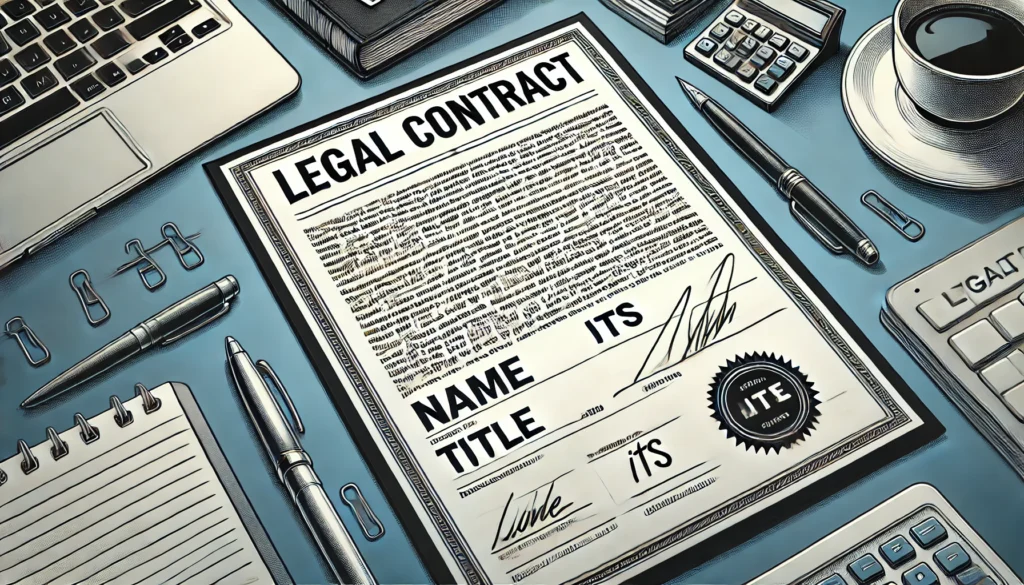When dealing with contracts, clarity is crucial. Every detail in the agreement, including terms, roles, and signatures, needs to be precise to ensure all parties understand their responsibilities and commitments. One often-overlooked but important detail is the question: what does its mean on a contract? While it may seem simple, understanding this term can prevent confusion and ensure that agreements are legally binding and properly executed. In this article, we will explore the significance of “its,” where it appears in contracts, and why it is so important.
What Does “Its” Mean in a Contract?
In a contract, “its” is a possessive pronoun used to refer to an organization or entity rather than an individual person. It indicates that the individual signing the contract is doing so on behalf of the organization they represent, not in a personal capacity.
For example, if an individual is signing a contract on behalf of a company, they might write:
“Its: Chief Executive Officer” or “Its: President” to specify the organization and the role of the person signing.
The term “its” helps clarify that the contract is binding not on the individual, but on the company or entity they represent. This is crucial because a company, as a legal entity, can enter into contracts, own property, and be held liable for obligations, while an individual might only be accountable for their personal actions.
Why Is “Its” Important in Contracts?
The use of “its” in a contract serves several essential functions, each contributing to the clarity and enforceability of the agreement. Here’s why “its” matters:
- Clarifies Legal Authority: The term helps establish that the person signing the contract has the proper authority to do so on behalf of the organization. It’s important to confirm that the person holding the pen has the legal right to make binding decisions for the entity.
- Prevents Disputes: By specifying the role of the individual signing the contract (e.g., CEO, CFO, or Director), “its” helps prevent legal disputes regarding whether the signer had the authority to commit the organization to the agreement.
- Ensures Proper Representation: “Its” makes it clear that the organization is the party agreeing to the terms, not the individual. This is vital for ensuring that the correct party is held accountable if the contract is ever challenged.
- Protects Both Parties: A well-drafted contract with clear designation of who is signing can protect both the organization and the other party involved. If there’s ever an issue or breach of contract, it’s clear who is responsible.
Examples of “Its” in a Contract
The term “its” is typically followed by the title of the person signing the contract. Here are some examples of how it might be used in a signature block:
- Its: CEO – The individual signing is the Chief Executive Officer of the company, and they are signing on behalf of the company.
- Its: Director – The individual holding the position of Director has the authority to bind the organization to the terms of the contract.
- Its: Authorized Representative – In some cases, a specific authorized representative (not necessarily a top executive) might sign, confirming that they hold the power to do so for the company.
These examples show that the term “its” is not just a grammatical form, but a tool to indicate authority and responsibility.
Where Does “Its” Appear in a Contract?
In most contracts, “its” will appear in the signature block, which is the section at the end of the document where the parties involved sign the agreement. The signature block generally includes:
- The name of the organization or entity entering into the agreement.
- The name of the person signing the document.
- The title or position of the signer (following “its”).
- The signature of the person authorized to sign.
A typical signature block might look something like this:
In this example, “its: CEO” indicates that the CEO is signing the contract on behalf of XYZ Corporation. This helps both parties involved understand that the CEO has the power to make decisions for the company and that the company itself is committing to the contract, not just the individual.
Legal Implications of Incorrect or Missing “Its”
If “its” is used incorrectly or omitted entirely, it can lead to significant legal issues. Here are some possible consequences of misusing “its” in a contract:
- Invalid Contracts: A contract could be challenged if it’s unclear who is authorized to sign. Without the proper title and role, a signature might not be legally binding.
- Confusion About Authority: If the person signing the contract doesn’t have proper authority, the other party may later claim that they didn’t know they were entering into an agreement with the company or entity, leading to disputes.
- Problems with Enforcement: If the signer’s authority is not clear, the contract might not be enforceable in a court of law. It’s vital to make sure the signer’s title matches their authority level to bind the organization.
In extreme cases, a contract signed without clear representation could be nullified, leaving one or both parties vulnerable to legal consequences or financial losses.
How to Properly Use “Its” in a Contract
To ensure that “its” is used correctly in a contract, consider the following steps:
- Verify the Signer’s Role: Before drafting or signing a contract, ensure that the person signing holds a position of authority within the organization. This could be the CEO, CFO, Director, or any other title that signifies they have the power to represent the company legally.
- Use the Correct Title: Make sure that the title used after “its” is the one that matches the individual’s role in the company. If the person is a Senior Vice President, the title should reflect that, and not a different position they don’t hold.
- Consult Legal Documents: If unsure about who has the authority to sign, consult your organization’s bylaws or board resolutions. These documents usually outline who is authorized to sign contracts on behalf of the company.
- Review the Signature Block: Always double-check the signature block to ensure that all titles and names are correct and clearly indicate authority. This is one of the most critical areas of any contract.
Common Misunderstandings About “Its”
There are a few common misconceptions that people might have about the term “its” in contracts:
- Misunderstanding Its Necessity: Some may think that specifying the signer’s role is unnecessary or redundant, especially in informal agreements. However, without this clarity, a contract could become legally ambiguous.
- Assuming Anyone Can Sign: It’s important to note that not every employee or member of an organization can sign on its behalf. Only those with legal authority can do so. Using “its” helps confirm that the person has been granted such authority.
- Confusion Between “Its” and “He/She”: “Its” refers to an organization or entity, while “he/she” refers to an individual. It’s essential to keep this distinction clear to avoid mistakes in legal documents.
Conclusion
The use of “its” in a contract is more than just a grammatical detail—it is a fundamental element of clarity and legal accountability. Understanding what does its mean on a contract ensures that the agreement is not only legally binding but also clear about who is representing the organization and committing it to the terms. By specifying the signer’s role and authority, “its” helps prevent misunderstandings and protects all parties involved from potential legal disputes.
When drafting or reviewing a contract, pay close attention to the signature block to ensure that “its” is used correctly. This seemingly small term plays a significant role in the enforceability, accuracy, and professionalism of contracts, safeguarding you from potential future complications.
FAQs
What does “its” mean in a contract?
“It’s” identifies the title or position of the person signing on behalf of an organization, ensuring proper representation.
Why is “its” important in the signature block?
It clarifies the authority of the signer, confirming they can legally bind the organization to the agreement.
Can a contract be valid without “its”?
Omitting “its” can lead to ambiguity, risking disputes over whether the signer had the authority to act for the organization.
Who should use “its” in a contract?
Anyone signing on behalf of an organization, such as CEOs, managers, or authorized representatives, should include “its” with their title.
Where does “its” typically appear in a contract?
It appears in the signature block, alongside the signer’s name and organization, to denote their role.
Article Recommendations
Wingate Wilderness Lawsuit: Legal, Social, and Ecological Dimensions Explored
Wordscapes Lawsuit: Lessons for Developers on Copyright Compliance and Licensing
Kerrigan Somerville Lawyer Yoga: Practical Strategies for Integrating Wellness Into a Legal Career
Chula Vista Mesothelioma Lawyer Vimeo: Discover Your Legal Options Through Online Resources















